What is a Polygon?
A polygon is a closed curve (figure) formed by the line segments such that:
- No line segments intersect except at their endpoints.
- No two line segments with a common endpoint are coincident.
In other words, a closed figure formed a three or more line segment is called a polygon.
Triangles, quadrilaterals, pentagons, hexagons, octagons are all examples of polygons. The name of the shape tells us the number of sides it has. For example, a triangle has 3 sides, as “Tri” means 3. Similarly, the Pentagon has 5 sides as “Penta” means 5. A regular polygon is a polygon whose all sides and all angles are equal. Let us see how to calculate the area of some polygons.
Polygons are classified according to the number of sides as follows:
| Number of Sides or Vertices | Name of the Polygon |
| 3 | Triangle |
| 4 | Quadrilateral |
| 5 | Pentagon |
| 6 | Hexagon |
| 7 | Heptagon |
| 8 | Octagon |
| 9 | Nonagon |
| 10 | Decagon |
Area of a Rectangle
A rectangle is a type of quadrilateral that equal opposite sides and four right angles.
Here we have a rectangle, covered with small squares. Each small square stands for 1 square centimetre, that is, each small square is cm on each side.

Count the number of squares that cover each rectangle. This will give you the area of a rectangle in square centimetres. Also, write the length and breadth of each rectangle. What do you observe? Let’s find out.
Rectangle 1
Number of small squares = 18
Area = 18 cm2 or 18 sq. cm
Length = 6 cm
Breadth = 3 cm
Rectangle 2
Number of small squares = 20
Area = 20 cm2 or 20 sq. cm
Length = 5 cm
Breadth = 4 cm
From the above examples, you can see that there is a quicker way to find the area in each case without having to count the number of squares. Since 6 x 3 = 18 and 5 x 4 = 50, we can say that the area of each of the two rectangles can be found out by multiplying the measures of length and breadth of the rectangle.
Area of a rectangle having length ‘l’ and breadth ‘b’ is given by l x b
For example, let us consider a rectangle having a length of 8 cm and a breadth of 7 cm as shown in the figure below.
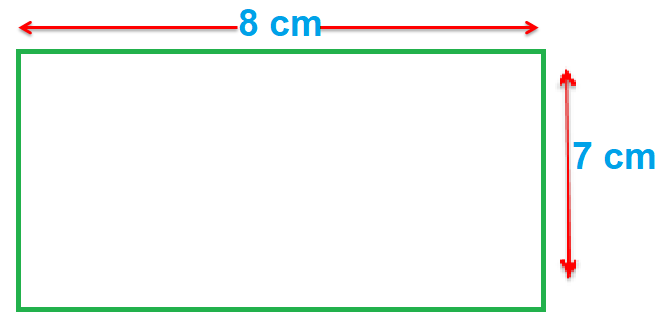
The area of this rectangle is given by 8 7 7 = 56 cm2.
Hence
Area of a rectangle = length x breadth
How to calculate the length and breadth of a rectangle using its area?
We now know how to calculate the area if we have the length and the breadth of a rectangle. But, if only the length or breadth and area are given, is it possible to know the breadth of the rectangle? Let us find out.
Since, Area of a rectangle = Length x Breadth,
Therefore,
Length = $\frac{Area}{Breadth}$, Breadth = $\frac{Area}{Length}$
Let us understand it more through an example.
Example 1
Find the length of a rectangle, if its area = 90cm2 and breadth = 6 cm
Solution
We are given that area = 90cm2 and breadth = 10 cm
Now, Length = $\frac{Area}{Breadth}$
Hence, Length = $\frac{90}{6}$ cm = 15 cm
Therefore, the length of the rectangle having area = 90cm2 and breadth = 6 cm is 15 cm
Example 2
A grassy plot is 80 m x60 m. Two cross paths each 4 m wide are constructed at right angles through the centre of the field, such that each path is parallel to one of the sides of the rectangles. Find the total area used path. Also, find the cost of gravelling them at £ 5 per square metre.
Solution
An important strategy for solving such questions is to first visualise them. Therefore, we will construct the rectangle and plot the details we have been given in the question.
Let the ABDC and PQSR be the rectangular paths that are to be constructed at right angles through the centre of the field, such that each path is parallel to one of the sides of the rectangles. We have,
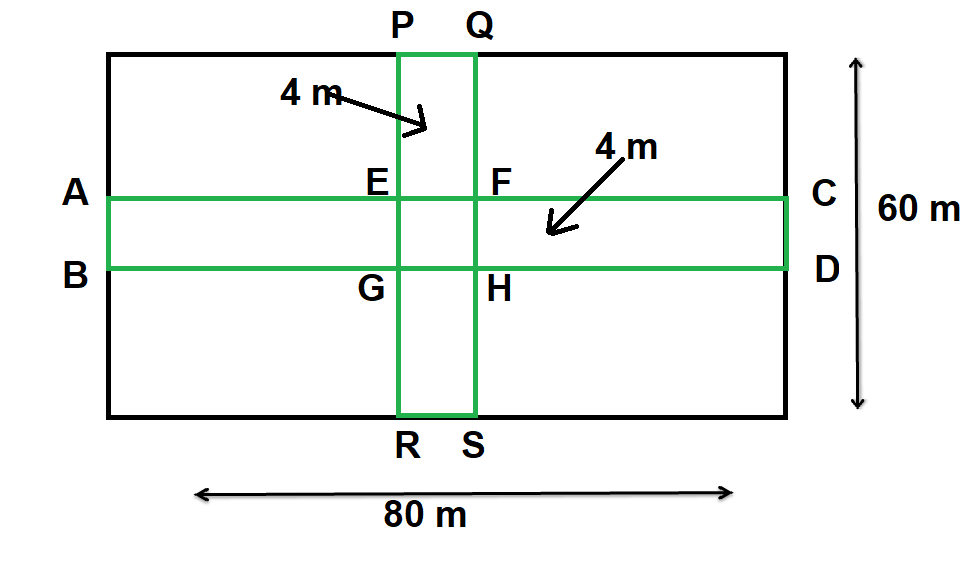
We have to find the total area used path.
First, we will calculate the area of the path ABDC.
Since the grassy plot is a rectangle and we know that area of a rectangle having length ‘l’ and breadth ‘b’ is given by l x b, therefore,
Area of the path ABDC = (80 x 4) m2 = 320 m2
Again, let us now find out the area of the path PQSR which can be calculated in the same manner as done above.
We have,
Area of the path PQSR = (60 x 4) m2 = 240 m2
But, with the help of our figure, we can clearly see that the area of EFHG is common to both the areas that we have calculated just now. Hence we need to subtract this area once from our result to avoid counting it twice.
Area of the path EFHG = (4 x 4) m2 = 16 m2
Therefore,
Total area of the path = Area of the path ABDC + Area of the path PQSR – Area of the path EFHG
Hence,
Total area of the path = (320 + 240 – 16 ) m2 = 544 m2
Now, let us cost for gravelling the path.
We have been given that the cost of gravelling the path is £5 per square metre.
Since the total area to be gravelled is 544 m2, therefore,
The total cost of gravelling the path would be £ (544 x 5) = £2720.
Area of a Square
A square is a quadrilateral that has four equal sides and four right angles.
For a square whose side is of ‘s’ units:
Area of a Square = Side x Side = s2 sq. units
For example, if we have a square whose one side is 6 cm, its area would be calculated as
Area = Side x Side = 6 x 6 = 36 cm2
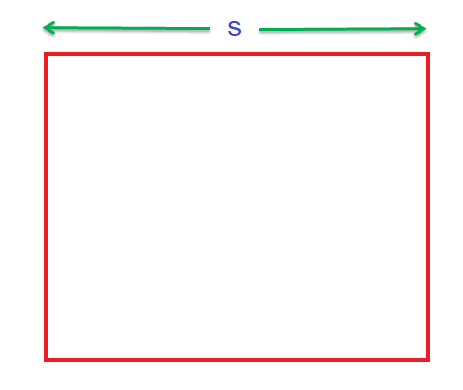


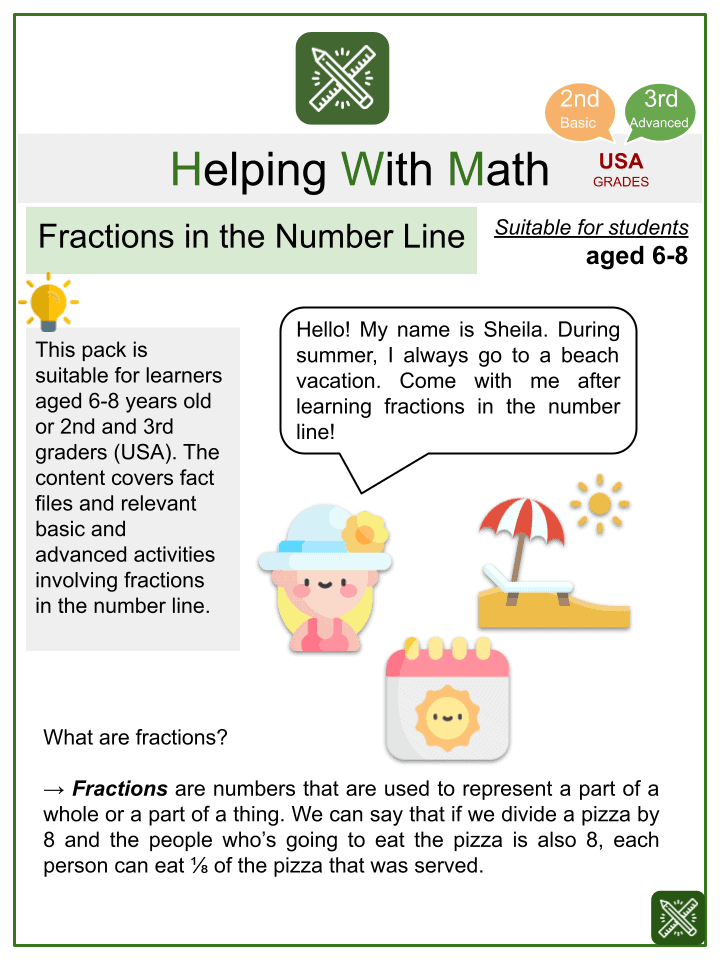
Area of a Triangle
A triangle is a polygon that is made of three edges and three vertices. The vertices join together to make three sides of a triangle. The area occupied between these three sides is called the area of a triangle.
The area of a triangle is defined by $\frac{1}{2}$ x b x h
Where b = base of the triangle (or any one side of the triangle)
And
H = Height of the triangle from that base (or side)
The following figure illustrates the base and the height of a triangle
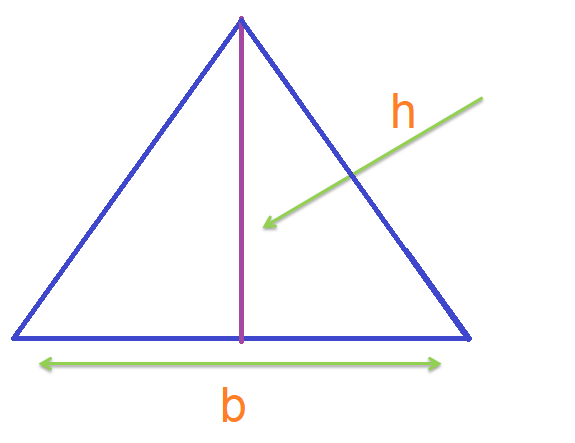
The above formula is applicable irrespective of the fact whether a triangle is a scalene triangle ( having different sides), an isosceles triangle ( having two sides equal), or an equilateral triangle ( having all sides equal).
Let us understand this more through an example. Suppose we have a triangle that has one side as 6 cm and an altitude (height) of 8 cm on that base as shown in the following figure:
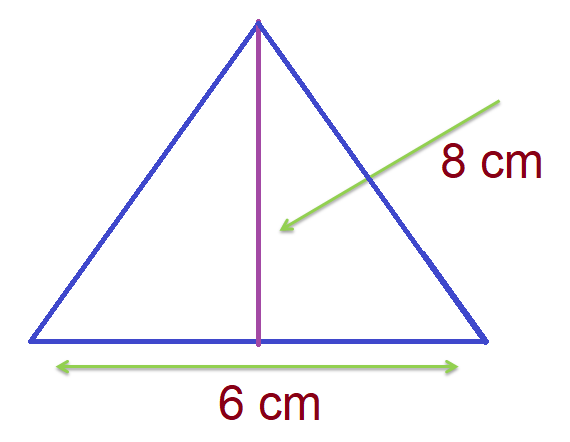
The area of this triangle is given by
$\frac{1}{2}$ x b x h
Where b = 6 cm and h = 8 cm
Therefore, Area = $\frac{1}{2}$ x 6 x 8 = 24 cm2
Area of a Parallelogram
A parallelogram is a quadrilateral, whose each pair of opposite sides is parallel. Suppose we have a parallelogram ABCD such that AB and DC are a pair of its opposite sides so that AB ‖ BC. Similarly, BC and AD are a pair of opposite sides such that BC ‖ AD.
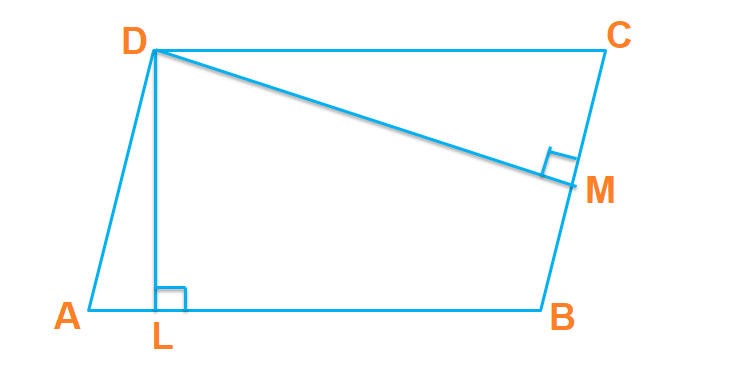
If DL ⟂AB, then any line, then we find any line segment with its end-points on the two sides AB and DC perpendicular to them has the length DL.so, we call AB as the base and DL the corresponding altitude.
Similarly, if DM ⟂BC, then any line segment with its end-points on the two sides AB and DC perpendicular to them has the length DM. so we can call BC as the base and DM as the corresponding altitude.
We have,
Area of a parallelogram = Base x Altitude
Altitude is also known as height. So, we can say that,
Area of a parallelogram = Base x Height
For example, let us find the area of a parallelogram having the base = 5 cm and altitude = 4.2 cm.
We know that
Area of a parallelogram = Base x Altitude
Here, base = 5 cm and altitude = 4.2 cm
Therefore,
Area = (5 x 4.2) cm2 = 21 cm2
Area of a Rhombus
Rhombus is a parallelogram with all its sides equal. Some properties of a rhombus are:
- All sides of a rhombus are equal.
- Since all the sides of a rhombus are equal, it is also known as an equilateral quadrilateral.
- The diagonals of a rhombus bisect each other at right angles.
- Apart from using the sides, the area of a rhombus can also be calculated using its diagonals.
Area of a Rhombus using its Sides
Since the rhombus is a parallelogram with all its sides equal, therefore, the formula for the area of a parallelogram also holds true for calculating the area of a rhombus.
Hence
Area of a Rhombus = Base x Height
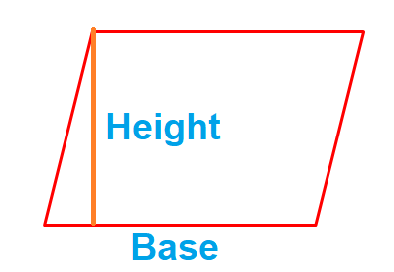
Example,
Let us have a rhombus whose altitude is 7 cm and the rhombus has a perimeter of 180 cm.
Solution
We are given that
The altitude of the rhombus = 7 cm
The perimeter of the rhombus = 180 cm.
We need to find the area of the rhombus. In order to do so, we must first find the side of the rhombus.
Now, remember that the perimeter of a closed shape is the sum of all its sides. Since the rhombus is a quadrilateral with all its sides equal, we can say that if the rhombus has a side “a”, then
a + a + a + a =180 cm
4a = 180 cm
a = 45 cm
Hence the side (base) of the rhombus = 45 cm
Now, to calculate the area of a rhombus, we know that
Area of a Rhombus = Base x Height
Therefore,
Area = (45 x 7) cm2 = 315 cm2
Area of a Rhombus using its Diagonals
We can also calculate the area of a rhombus if we know its diagonals. The formula for calculating the area of the rhombus when we know its diagonals is given by:
Area of a Rhombus = $\frac{1}{2}$ x (Product of the diagonals)
If d1 and d2 are two diagonals of a rhombus, then,
Area of a Rhombus = $\frac{1}{2}$ x (d1 x d2)
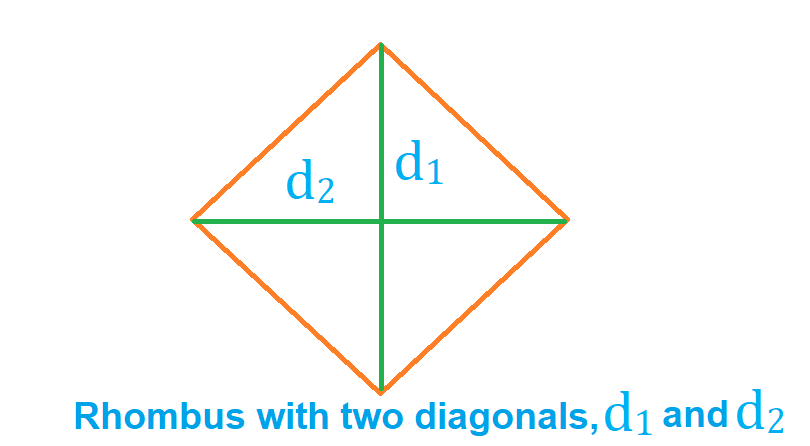
Example
If the two diagonals of a rhombus measure 9 cm and 12 cm respectively, find the area of the rhombus.
Solution
We know that we are given the diagonals, the area of the rhombus = $\frac{1}{2}$ x (d1 x d2)
Here, the two diagonals are 9 cm and 12cm.
So, let
D1 = 9 cm and d2 = 12 cm.
Area of the rhombus = $\frac{1}{2}$ x (d1 x d2) = $\frac{1}{2}$ x (9 x 12) cm2 = 54 cm2
Hence, area of the rhombus = 54 cm2
Area of a Hexagon
A hexagon is a polygon having six sides. A regular hexagon is a hexagon that has its all sides equal.

Some important properties of a hexagon include:
1. A hexagon has 9 diagonals

2. Sum of the interior angles of a hexagon is equal to 720o
The area of a regular hexagon can be calculated if we know one side of the hexagon. Let one side of a regular hexagon be “s”. Then the formula for calculating the area of a regular hexagon would be:
Area of a Hexagon = $\frac{3\sqrt{3}}{2}s^{2}$
Example
Find the area of a regular hexagon, whose each side measures 6 cm.
Solution
To find the area of the hexagon, we need to know its side.
We are given that each side of the hexagon = 6 cm
Now, the area of a hexagon =$\frac{3\sqrt{3}}{2}s^{2}$
So, area = $\frac{3\sqrt{3}}{2}6^{2}$ =$\frac{3\sqrt{3}}{2}$ x 36 cm2= 54$\sqrt{3}$ cm2
Area of a Trapezium
A trapezium is a quadrilateral whose two sides are parallel.
Base: Each of the two sides of a trapezium is called the base of the trapezium.
Height or Altitude: The distance between the two bases (parallel lines) is called the height or altitude of the trapezium.
Below, we have the representation of the standard shape of a trapezium ABCD such that AB and CD are its parallel sides while AD and BC are its non-parallel sides.

Let h be the height of the trapezium ABCDD. Then DL = h
Area of trapezium ABCD = Area of ∆ABC + Area of ∆ACD
Area of trapezium ABCD = $\frac{1}{2}$ x AB x h + x DC x h
= $\frac{1}{2}$ x (AB + DC) x h
= $\frac{1}{2}$ x (Sum of parallel sides) x (Distance between parallel sides)
Hence,
Area of a trapezium = $\frac{1}{2}$ x (Sum of parallel sides) x (Distance between parallel sides)
Example
The area of a trapezium is 105 cm2 and its height is 7 cm. If one of the parallel sides is longer than the other by 6 cm, find the two parallel sides.
Solution
We have been given that:
Area of the trapezium = 105 cm2
Height of the trapezium = 7 cm
Also, one of the parallel sides is longer than the other by 6 cm.
Let one parallel side of the trapezium be p cm. Then, according to the question the other parallel side of the trapezium will be (p + 6) cm
Now, we know that
Area of a trapezium = $\frac{1}{2}$ x (Sum of parallel sides) x (Distance between parallel sides)
Therefore, putting the values we have in the above equation we get,
105 = $\frac{1}{2}$ x (p + p + 6) x 7
⇒105 x 2 = (2p + 6) x 7
⇒ 210 = 14p + 42
⇒14p = 210 – 42 = 168
⇒ p = $\frac{168}{14}$ = 12 cm
Therefore, one parallel side of the trapezium = 12 cm.
The other parallel side of the trapezium = (12 + 6) cm = 18 cm
Hence, the two parallel sides of the trapezium are 12 cm and 18 cm
Remember
- A closed figure formed a three or more line segments is called a polygon.
- Polygons are classified according to the number of sides.
- Area of a rectangle = length x breadth
- Area of a Square = Side x Side = s2 sq. units
- Area of a triangle = $\frac{1}{2}$ x b x h, where b = base, h = height
- The area of a circle having a radius ‘r’ = πr2 where π = $\frac{22}{7}$ or 3.14 (approx.)
- Area of a parallelogram = Base x Altitude
- Area of a Rhombus = Base x Height
- If d1 and d2 are two diagonals of a rhombus, then, Area of a Rhombus = $\frac{1}{2}$ x (d1 x d2)
- Area of a Hexagon =$\frac{3\sqrt{3}}{2}s^{2}$
- Area of a trapezium = $\frac{1}{2}$ x (Sum of parallel sides) x (Distance between parallel sides)
Recommended Worksheets
Frequency Polygon (School Themed) Math Worksheets
Word Problems Involving Perimeter and Area of Polygons (Carpentry Themed) Worksheets
Perimeter of Polygons (Construction Themed) Worksheets









